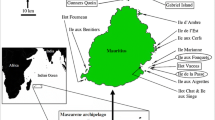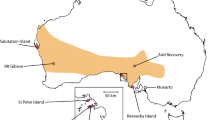Abstract
The translocation of individuals from onepopulation to another is a common technique inwildlife conservation. However, the outcome oftranslocation programs is not always properlyevaluated and the relative contribution ofreleased individuals to the resident populationoften remains unknown. We used mitochondrialDNA and autosomal genetic markers to evaluatethe success of a translocation program ofEurasian otters (Lutra lutra) in Sweden.The program is regarded as successful becauseof subsequent population growths. Norwegianotters used for the restocking program could begenetically differentiated from Swedish otters.The releases took place at two sites. In anarea south of the first site, where 47 otterswere released, no genetic contribution of theintroduced animals to the population could beobserved and the genetic diversity was lowerthan before the releases. At the second site,the release of seven otters led to a change ingenetic composition of the resident population.The results of this study suggest that thegrowth of the otter population after therestocking may not be as dependent on thereleases as initially suspected. The geneticeffects of the translocations appear to berestricted to areas in the immediate vicinityof the release sites.
Similar content being viewed by others
References
Arrendal J (2000) Microsatellite Analysis of the Genetic Variation in the Eurasian otter (Lutra lutra) in Sweden. Master thesis, Department of Evolutionary Biology, EBC, Uppsala University, Sweden.
Bassam BJ, Caetano-Anolles G, Gresshoff PM (1991) Fast and sensitive silver staining of DNA in polyacrylamide gels. Analytical Biochemistry, 196, 80.
Belkhir K et al. (2000) GENETIX 4.0, logicien sous Windows TM pour la génétique des populations. Laboratoire Génome, Populations, Interactions, CNRS UPR 9060, Université de Montpelier II, Montpelier, France.
Bisther M (2000) Utter i sydöstra Sverige-inventering 2000. Föreningen Rädda Uttern i Småland.
Breitenmoser U, Breitenmoser-Würsten C, Carbyn LN, Funk SM (2001) Assessment of carnivore reintroductions. In: Carnivore Conservation (eds. Gittleman JL, Funk SM, Macdonald D, Wayne RK), pp. 241–281. Cambridge University Press, Cambridge.
Cassens I, Tiedemann R, Suchentrunk F, Hartl GB (2000) Mitochondrial DNA variation in the European otter (Lutra lutra) and the use of spatial autocorrelation analysis in conservation. Journal of Heredity, 91, 31–35.
Dallas JF, Piertney SB (1998) Microsatellite primers for the Eurasian otter. Molecular Ecology, 7, 1247–1263.
Dallas JF, Bacon PJ, Carss DN, Conroy JWH, Green R, Jefferies DJ, Kruuk H, Marshall F, Piertney SB, Racey PA (1999) Genetic diversity in the Eurasian otter, Lutra lutra, in Scotland. Evidence from microsatellite polymorphism. Biological Journal of the Linnean Society, 68, 73–86.
Dobson A, Lyles A (2000) Black-footed ferret recovery. Science, 288, 985–988.
Ebert D, Haag C, Kirkpatrick M, Riek M, Hottinger JW, Pajunen VI (2002) A selective advantage to immigrant genes in a Daphnia metapopulation. Science, 295, 485–488.
Effenberger S, Suchentrunk F (1999) RFLP analysis of the mitochondrial DNA of otters (Lutra lutra) from Europe-implications for conservation of a flagship species. Biological Conservation, 90, 229–234.
Ellsworth DL, Honeycutt RL, Silvy NJ, Smith MH, Bickham JW, Klimstra WD (1994) White-tailed deer restoration to the southeastern United States: Evaluating genetic variation. Journal of Wildlife Management, 58, 686–697.
Erlinge S (1971) Utter-en artmonografi. Bonniers, Stockholm.
Fischer J, Lindenmayer DB (2000) An assessment of the published results of animal relocations. Biological Conservation, 96, 1–11.
Goossens B, Funk SM, Vidal C, Latour S, Jamart A, Ancrenaz M, Wickings EJ, Tutin CEG, and Bruford MW (2002) Measuring genetic diversity in translocation programmes: Principles and application to a chimpanzee release project. Animal Conservation, 5, 225–236.
Grewe PM, Krueger CC, Marsden JE, Aquadro CF, May B (1994) Hatchery origins of naturally produced lake trout fry captured in Lake Ontario: temporal and spatial variability based on allozyme and mitochondrial DNA data. Transactions of the American Fish Society, 123, 309–320.
Hammar G (1996) Inventering av utter(Lutra lutra) i Uppland 1995. Rapport 1996:3. Norrtälje Naturvårdsfond, Norrtälje.
Hartl DL, Clark AG (1989) Principles of Population Genetics. Sinauer Associates, Sunderland, Massachusetts.
Hayashi K (1991) PCR-SSCP: A simple and sensitive method for detection of mutations in the genomic DNA. PCR Methods and Applications, 1, 34–38.
Hoelzel AR, Lopez JV, Dover GA, O'Brien SJ (1994) Rapid evolution of a heteroplasmic repetitive sequence in the mitochondrial DNA control region of carnivores. Journal of Molecular Evolution, 39, 191–199.
Ingvarsson PK (2001) Restoration of genetic variation lost-the genetic rescue hypothesis. Trends in Ecology and Evolution, 16, 62–63.
Ingvarsson PK, Whitlock MC (2000) Heterosis increases the effective migration rate. Proceedings of the Royal Society of London, Series B, 267, 1321–1326.
Jones MW, Clay D, Danzmann RG (1996) Conservation genetics of brook trout (Salvelinus fontinalis): Population structuring in Fundy National Park, New Brunswick, and eastern Canada. Canadian Journal of Fisheries and Aquatic Sciences, 53, 2776–2791.
Largiadèr CR, Scholl A (1995) Effects of stocking on the genetic diversity of brown trout populations of the Adriatic and Danubian drainages in Switzerland. Journal of Fish Biology, 47, 209–225.
Larsson K, Ebenhard T (1994) Isolerade delpopulationer av utter: en sårbarhetsanalys. Världsnaturfonden WWF, Stockholm.
Leberg PL, Ellsworth DL (1999) Further evaluation of the genetic consequences of translocations on southeastern white-tailed deer populations. Journal of Wildlife Management, 63, 327–334.
Leberg PL, Stangel PW, Hillestad HO, Marchinton RL, Smith MH (1994) Genetic structure of reintroduced wild turkey and whitetailed deer populations. Journal of Wildlife Management, 58, 698–711.
Länsstyrelsen Gävleborg (1998) Uttern i Gävleborg tio år senare. Rapport 1998:11. Länsstyrelsen Gävleborg, Gävle.
Madsen T, Shine R, Olsson M, Wittzell H (1999) Conservation biology: Restoration of an inbred adder population. Nature, 402, 34–35.
Mucci N, Pertoldi C, Madsen AB, Loeschcke V, Randi E (1999) Extremely low mitochondrial DNA control-region sequence variation in the otter Lutra lutrapopulation of Denmark. Hereditas, 130, 331–336.
Nedbal MA, Honeycutt RL, Evans SG, Whiting RM Jr, Dietz DR (1997) Northern bobwhite restocking in east Texas: a genetic assessment. Journal of Wildlife Management, 61, 854–863.
Nei M (1978) Estimation of average heterozygosity and genetic distance from a small number of individuals. Genetics, 89, 583–590.
Paetkau D, Calvert W, Sterling I, Strobeck C (1995) Microsatellite analysis of population structure in Canadian polar bears. Molecular Ecology, 4, 347–354.
Parsons DR (1998) “Green fire” returns to the Southwest: reintroduction of the Mexican wolf. Wildlife Society Bulletin, 16, 799–807.
Pertoldi C, Møller-Hansen M, Loeschcke V, Madsen AB, Jacobsen L, and Baagoe H (2001) Genetic consequences of population decline in the European otter (Lutra lutra): an assessment of microsatellite DNA variation in Danish otters from 1883-1993. Proceedings of the Royal Society of London, Series B, 268, 1775–1781.
Raymond M, Rousset F (1995) GENEPOP (version 1.2): population genetics software for exact tests and ecumenicism. Journal of Heredity, 86, 248–249.
Rice WR (1988) Analyzing tables of statistical tests. Evolution, 43, 223–225.
Rowe G, Beebee TJC, Burke T (1998) Phylogeography of the natterjack toad Bufo calamitain Britain: Genetic differentiation of native and translocated populations. Molecular Ecology, 7, 751–760.
Sambrook J, Fritsch EF, Maniatis T (1989) Molecular Cloning: A Laboratory Manual, 2nd edition. Cold Spring Harbor Laboratory Press, New York.
Sjöåsen T (1995) Re-introduction of European otters in Sweden. IUCN Re-introduction News, 10, 10–11.
Sjöåsen T (1996a) Survivorship of captive-bred and wild-caught reintroduced European otters Lutra lutrain Sweden. Biological Conservation, 76, 161–165.
Sjöåsen T (1996b) Utterinventering i Södermanland 1996. Zoologiska institutionen, Stockholms universitet, Stockholm.
Sjöåsen T (1997) Movements and establishment of reintroduced European otters Lutra lutra. Journal of Applied Ecology, 34, 1070–1080.
Snyder N, Snyder H (2000) The California Condor. A Saga of Natural History and Conservation.AP NaturalWorld (Academic Press), San Diego, CA.
Vilà C, Sundqvist A-K, Flagstad Ø, Seddon J, Björnerfeldt S, Kojola I, Sand H, Wabakken P, Ellegren H (2003) Rescue of a severely bottlenecked wolf (Canis lupus) population by a single immigrant. Proceedings of the Royal Society Biological Sciences, 270, 91–97.
Weir BS, Cockerham CC (1984) Estimating F-statistics for the analysis of population structure. Evolution, 38, 1358–1370.
Westemeier RL, Brawn JD, Simpson SA, Esker TL, Jansen RW, Walk JW, Kershner EL, Bouzat JL, Paige KN (1998) Tracking the long-term decline and recovery of an isolated population. Science, 282, 1695–1698.
Wright S (1965) The interpretation of population structure by Fstatistics with special regard to systems of mating. Evolution, 19, 395–420.
Author information
Authors and Affiliations
Corresponding author
Rights and permissions
About this article
Cite this article
Arrendal, J., Walker, C.W., Sundqvist, AK. et al. Genetic evaluation of an otter translocation program. Conservation Genetics 5, 79–88 (2004). https://doi.org/10.1023/B:COGE.0000014059.49606.dd
Issue Date:
DOI: https://doi.org/10.1023/B:COGE.0000014059.49606.dd




